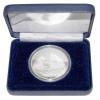Riga ship
Struck and issued in 1998 (dated 1997)
During the 1939 archaeological excavations in Old Riga in, a group of archaeologists headed by the Director of the Riga City History Museum Rauls Snore (1901-1962) found fragments of a ship in territory of the old Riga port, once situated on the bank of the river Riga. The ship lay some 6.5 metres below the present street level, in-between Valnu, Ridzenes and 13. Janvara Streets.
The so-called Riga ship was a clinker-built sailing-ship, with a high bow, one mast and a yard. Her body and boarding were made of oak, while the interior was lined with pine panels. It is likely that the boards had been trimmed with an axe (no trace left by a saw was detected). Joints were secured with wooden pegs, iron nails and rivets. The ship's dimensions, according to estimates, were the following: length 17 metres, width 4.9 metres, height of the boards in the middle part 2.4 metres, draught 1 metre, weight 4 300 kilograms, and carrying capacity 30 tons.
During the Second World War, some fragments of the ship were destroyed. Research was resumed in 1970, when technical drawings of the Riga ship were made and an oak model was constructed according to the scale 1:10. Scientists assume that this unique finding dates back to the end of the 12th century. The fragments and model of the Riga ship are displayed at the Museum of the History of Riga and Navigation and depicted on the reverse of the collector coin of the Bank of Latvia. The obverse shows the large coat of arms of the Republic of Latvia.





